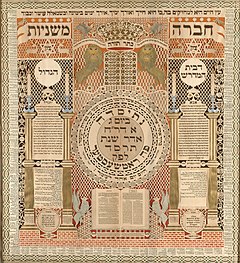
Back Sefirat ha-ómer Catalan Počítání omeru Czech Omer-Zählen German Cuenta del Omer Spanish شمارش اومر Persian Décompte de l'omer French ספירת העומר HE Ómerszámlálás Hungarian Penghitungan Omer ID Conteggio dell'Omer Italian
| Counting of the Omer | |
|---|---|
 Omer Calendar | |
| Observed by | Jews (In various forms also by: Samaritans; Messianic Jews and other Christians, some groups claiming affiliation with Israelites) |
| Type | Jewish and Samaritan, religious |
| Begins | 16 Nisan |
| Ends | 5 Sivan |
| 2023 date | Sunset, 6 April – nightfall, 25 May |
| 2024 date | Sunset, 23 April – nightfall, 11 June |
| 2025 date | Sunset, 13 April – nightfall, 1 June |
| 2026 date | Sunset, 2 April – nightfall, 21 May |
| Related to | Passover, Shavuot |
| Part of a series on |
| Judaism |
|---|
   |
Counting of the Omer (Hebrew: סְפִירַת הָעוֹמֶר, Sefirat HaOmer, sometimes abbreviated as Sefira) is a ritual in Judaism. It consists of a verbal counting of each of the 49 days between the holidays of Passover and Shavuot. The period of 49 days is known as the "omer period" or simply as "the omer" or "sefirah".[1]
The count has its origins in the biblical command of the Omer offering (or sheaf-offering), which was offered on Passover, and after which 49 days were counted, and the Shavuot holiday was observed. The Temple sacrifices have not been offered since the destruction of the Temple in Jerusalem, but the counting until Shavuot is still performed. Shavuot is the only major Jewish holiday for which no calendar date is specified in the Torah; rather, its date is determined by the omer count.[1]
The Counting of the Omer begins on the second day of Passover (the 16th of Nisan) for Rabbinic Jews (Orthodox, Conservative, Reform), and after the weekly Shabbat during Passover for Karaite Jews. According to all practices, the 49-day count ends the day before Shavuot, which is the 'fiftieth day' of the count.
The omer ("sheaf") is an old Biblical measure of volume of unthreshed stalks of grain, the amount of grain used for the Temple offering.
- ^ a b "Counting the Omer and Israel's National Holidays - Jewish Tradition". yahadut.org. Retrieved 2024-04-01.